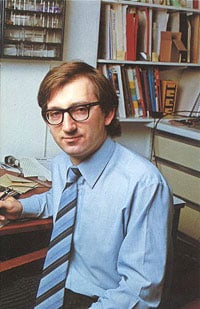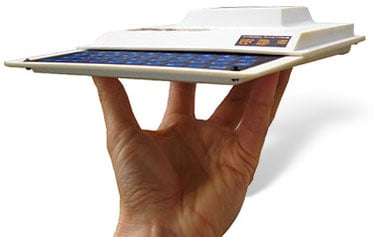While the name might not ring a bell, the Sinclair ZX80 computer is one of the most important predecessors to the modern laptop computers we know today. This home computer came along with the wave of microcomputers that were popular in the late 1970s and early 1980s which allowed users to plug the device into their home televisions and use it as they would use a business, scientific, or engineering computer. But how exactly did the Sinclair ZX80 come to be? What were its specs and different versions? And how was it received by the public? This complete history of the Sinclair ZX80 computer will tell you everything you need to know.
3 Facts About the Sinclair ZX80 Computer
- The Sinclair ZX80 computer was the first home computer under $200 in the United States.
- Tens of thousands of consumers hoping to get their hands on a Sinclair ZX80 computer were put on a waiting list at the time, which was totally unheard of at the time.
- The Sinclair ZX80 machine was made using 21 readily available TTL chips, meaning the only proprietary technology in the device was the firmware.
The Sinclair ZX80 Computer Specs
- 1, 2, or 3 KB of static RAM, with the option for 16 KB of dynamic RAM
- 4 KB of read-only memory (ROM)
- Black-and-white, character-based video output with some simple block-based graphics glyphs
- Sinclair BASIC programming language, editor, and operating system
- 3.25 MHz Z80 central processing unit
- No sound output
- 340 grams, 7″ x 9″

The History of the Sinclair ZX80 Computer: What to Know
In May of 1979, Jim Westwood, the Chief Engineer of Science of Cambridge Ltd (a British consumer electronics company incorporated by Sir Clive Marles Sinclair in 1973), shook up the home PC industry in a major way. Westwood set out to design a new microcomputer intended to replace the company’s first microcomputer kit, the MK14. The goal was to base the replacement microcomputer on the newly designed Zilog Z80 microprocessor. It took Westwood just nine months to develop the Sinclair ZX80, but don’t call it a rush job — the Sinclair ZX80, named after the microprocessor and incorporating an “X” to represent a so-called mystery ingredient, was a truly remarkable home PC.
Jim Westwood designed the computer using 21 readily available TTL chips, meaning the only proprietary technology in the revolutionary PC was the firmware. The Sinclair ZX80’s Z80 CPU was an NEC μPD780C-1 equivalent that ran at 3.25 MHz. It was equipped with 1 KB of static RAM and could handle a maximum of 64 KB. The Sinclair ZX80 also came with 4 KB of ROM that contained the Sinclair BASIC operating system, programming language, and editor.

First released in January of 1980, both as an assembled version for £99.95 (or $199.50 USD) and as a kit for £79.95, the Sinclair ZX80 computer’s unbelievable low price totally cracked open the microcomputer market. That’s because the Sinclair ZX80’s low price point and convenient, easy-to-use tech allowed more people than ever to be able to afford a home PC. These factors resulted in over 50,000 unit sales at the outset and a several-month-long waiting list for the ZX80 — a number that was completely unheard of for its time.
From word processing to programming to video games, the Sinclair ZX80 had the ability to outperform many of its competitors — and primarily with components that were already readily available, to boot. This only added fuel to this hugely popular fire.
The Sinclair ZX80 computer weighed in at just 340 grams, or ¾ of a pound, and was the first home computer to have a price tag of less than £100/$200. The PC was mounted in a tiny white plastic case with a one-piece blue membrane keyboard designed by Rick Dickinson, Sinclair’s in-house industrial designer for much of the 1980s. The Sinclair ZX80’s display was hooked to the user’s television, resulting in a theoretical 22” x 32” display with black-and-white characters. The ZX80 had memory and cassette ports for programs and games and was compatible with the Sinclair thermal printer.
The Sinclair ZX80 Computer Versions: Each Edition
U.S. Version
The U.S. version of this computer was marginally less popular than the U.K. version because of the presence of many American PC clones. Because the machine was U.K.-made, the only real major change to the U.S. version was to the video output frequency and the keyboard, which needed to be adapted to American standards and specs.
U.K./International Version
The U.K. and international versions of the Sinclair ZX80 had similar changes made in comparison to the U.S. version. For instance, a “Newline” key was used in place of “Enter”, “Rubout” was used in place of “Backspace” and “Delete”, and the keyboard was given a Pound symbol (or other relevant regional currency depending on the market).
The Public Response
The Sinclair ZX80 computer was an instant hit, thanks in part to the alluring advertising campaign that focused on its unbelievable low price of under £100 GBP/$200 USD. It’s easy to see how this PC ended up moving 100,000 units before the release of its eventual successor, the ZX-81, the following year.

Interestingly enough, both the pre-assembled and the unassembled kit versions of the PC were quite popular — this option for consumers to choose which they preferred allowed for both amateurs and experts alike to find enjoyment and feel a sense of pride in their purchase. Being a part of the assembly of the device really took the “personal” in PC to a new level.
While the device has long since been phased out, surviving ZX80 PCs still in good condition are like holy grails for collectors willing to pay high prices to get their hands on a working model. This is thanks entirely to its uncomplicated design, its innovative nature, its user-friendliness, and its important place on the timeline of the history of the computer as we know it.